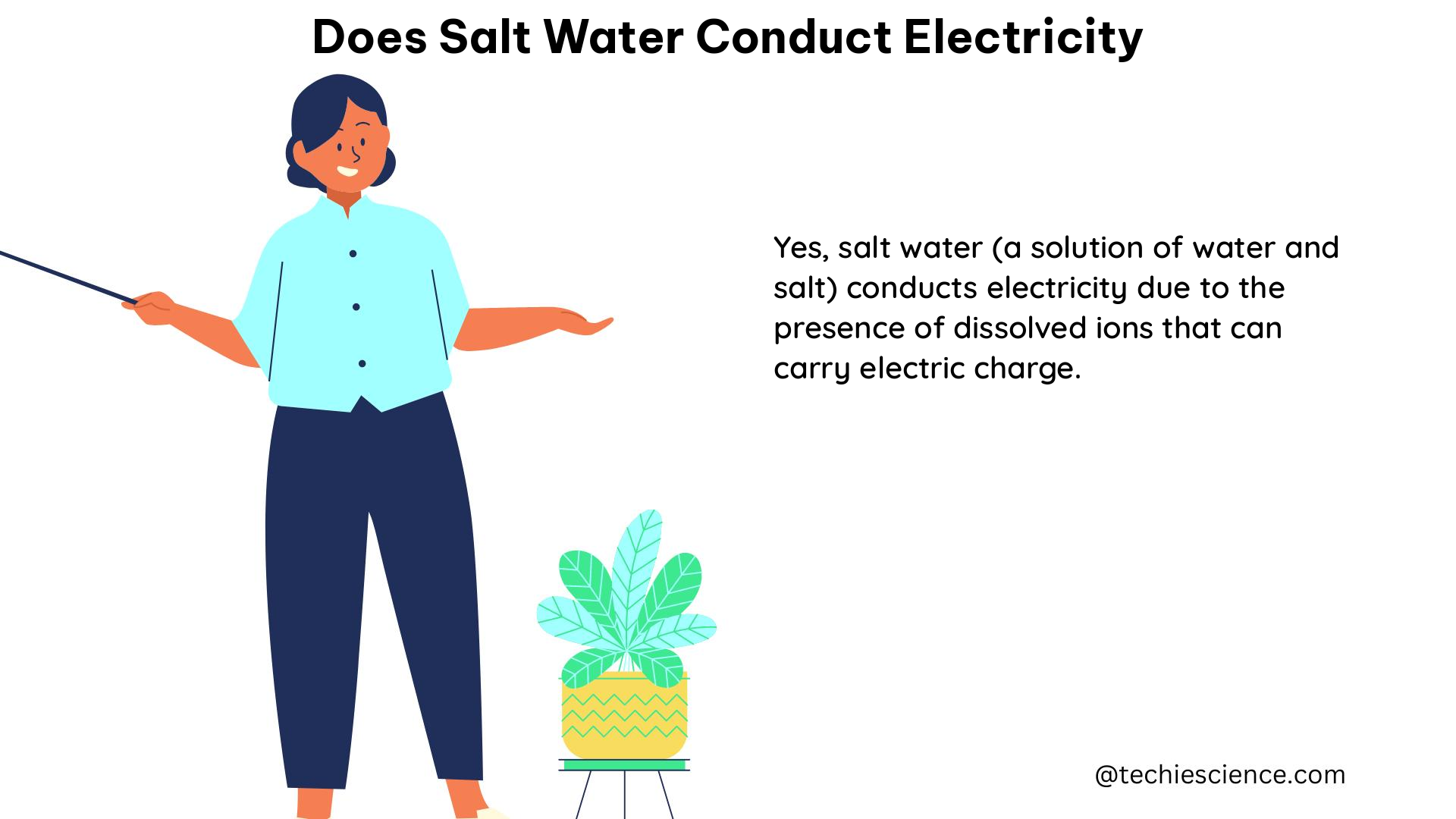Salt water is a highly conductive medium due to the presence of dissolved ions, making it an excellent conductor of electricity. This property has numerous applications in various fields, from electrochemistry to marine engineering. In this comprehensive guide, we will delve into the science behind the conductivity of salt water, explore the factors that influence it, and discuss the practical implications of this phenomenon.
Understanding the Conductivity of Salt Water
The conductivity of water is primarily determined by the presence of dissolved ions, which are charged particles that can move freely within the solution. When salt, such as sodium chloride (NaCl), is dissolved in water, it dissociates into positively charged sodium ions (Na+) and negatively charged chloride ions (Cl-). These ions are the key players in facilitating the flow of electric current through the water.
The conductivity of water can be expressed using the following formula:
Conductivity (σ) = Σ(n_i * q_i * μ_i)
Where:
– n_i is the number concentration of the i-th ion species
– q_i is the charge of the i-th ion species
– μ_i is the mobility of the i-th ion species
In the case of salt water, the primary contributors to the conductivity are the sodium (Na+) and chloride (Cl-) ions, which have high mobilities and charge values.
Factors Affecting the Conductivity of Salt Water

-
Salt Concentration: The higher the concentration of dissolved salt in the water, the greater the number of ions available to carry electric current. This is why seawater, with its high salt content, has a much higher conductivity compared to freshwater.
-
Temperature: As the temperature of the water increases, the conductivity also increases. This is because higher temperatures enhance the mobility of the ions, allowing them to move more freely and carry electric current more efficiently.
-
For example, the conductivity of seawater at 20°C is around 50 mS/cm, while at 30°C, it increases to approximately 55 mS/cm.
-
Impurities: The presence of other dissolved substances, such as minerals or organic matter, can also affect the conductivity of salt water. These impurities can either increase or decrease the overall conductivity, depending on their ionic nature and concentration.
-
Pressure: The conductivity of salt water can also be influenced by pressure. As depth increases in the ocean, the higher pressure can slightly increase the conductivity due to the compression of the water molecules and the increased mobility of the ions.
Practical Applications of Salt Water Conductivity
-
Electrochemical Processes: The high conductivity of salt water makes it an ideal medium for various electrochemical processes, such as electroplating, electrolysis, and corrosion control.
-
Marine Engineering: The conductivity of seawater is crucial in the design and operation of marine equipment, such as cathodic protection systems for ships and offshore structures, to prevent corrosion.
-
Desalination and Water Treatment: Understanding the conductivity of salt water is essential in the development of desalination technologies, where the goal is to remove dissolved salts and minerals from the water.
-
Saltwater Circuits: Saltwater circuits, where the water acts as a conductive medium, can be used in various educational and experimental setups to demonstrate the principles of electricity and electrochemistry.
-
Aquaculture and Fisheries: The conductivity of water is an important parameter in aquaculture and fisheries, as it can affect the health and growth of aquatic organisms.
-
Environmental Monitoring: Measuring the conductivity of water bodies can provide valuable insights into the water quality, pollution levels, and the presence of dissolved ions, which is crucial for environmental monitoring and management.
Numerical Examples and Calculations
- Conductivity of Seawater:
- At 20°C, the conductivity of seawater is approximately 50 mS/cm.
-
At 30°C, the conductivity of seawater increases to around 55 mS/cm.
-
Conductivity of Freshwater:
- Distilled water has a very low conductivity of around 0.05 μS/cm due to the absence of dissolved ions.
- Drinking water typically has a conductivity range of 200 to 800 μS/cm, depending on the dissolved mineral content.
-
Rain or snow water has a conductivity range of 2 to 100 μS/cm.
-
Saltwater Circuit Experiment:
- In a saltwater circuit, the brightness of a light bulb is directly proportional to the salt concentration in the water.
- If the circuit does not conduct electricity, it indicates a lack of significant salt content in the water.
- By varying the salt concentration, the electric current flowing through the circuit can be controlled, allowing the light bulb to turn on with different intensities.
Conclusion
Salt water’s high conductivity is a result of the presence of dissolved ions, primarily sodium and chloride, which can freely move and carry electric current. This property has numerous applications in various fields, from electrochemistry to marine engineering. Understanding the factors that influence the conductivity of salt water, such as salt concentration, temperature, and impurities, is crucial for designing and optimizing systems that rely on this phenomenon.
Reference:
- Conductivity of Water
- Saltwater Circuit Project
- Electrolysis of Water
- Desalination and Water Treatment
- Science Fair Project on Saltwater Conductivity
I am Keerthi K Murthy, I have completed post graduation in Physics, with the specialization in the field of solid state physics. I have always consider physics as a fundamental subject which is connected to our daily life. Being a science student I enjoy exploring new things in physics. As a writer my goal is to reach the readers with the simplified manner through my articles.